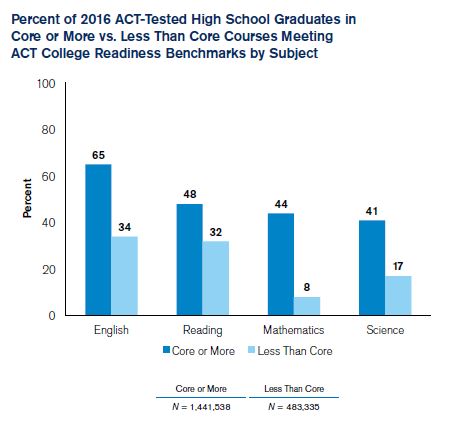Every year, millions of high school students across the United States take either the ACT or the SAT exam. Not only are they part of the admissions criteria at most colleges and universities, they are both looked at as ways to predict college and career readiness. Let’s take a look at some of the specifics.
The ACT is a standardized test used for college admissions and merit-based scholarships. It was developed in 1959 by American College Testing, and it currently tests students’ knowledge and skills in English, math, reading, and science (designed to test critical thinking, not specific scientific knowledge); it also contains an optional writing section. The maximum composite score is 36. In 2014, over 1.84 million high school graduates participated in this test, which is required as part of the admissions process for most college and university undergraduate programs in the United States and Canada. It is most popular with public schools and schools in the Midwest and South, and some states have a contract with ACT to use this test exclusively. Every four-year college in the U.S. accepts ACT scores.
The SAT is also a standardized test used for college admissions and merit-based scholarships. It was developed by the College Board’s Educational Testing Service (ETS) in 1926, and its name and manner of scoring have changed several times over the years, most recently in Spring 2016. It currently tests students’ knowledge and skills in writing, critical reading, and mathematics, and it also contains an optional essay section. The current maximum score is 1600. In 2015, over 1.69 million high school graduates participated in this test. It is most popular with private schools and schools on the east and west coasts; however, every four-year college in the U.S. accepts its scores.
Both exams may be taken multiple times, with the highest score being the one reported to colleges. The difference between the two exams can probably be best summed up as “The ACT and SAT are different tests that measure similar but distinct constructs. The ACT measures achievement related to high school curricula, while the SAT measures general verbal and quantitative reasoning.”[1] From a student’s scores on either exam, he can tell how well he did in relation to other students in his state and across the nation, and he can get a sense of whether he has scored high enough to undertake the major he has chosen.
Both organizations, but especially the ACT, have also gone beyond the tests themselves and done considerable research to determine what contributes to college and career readiness. The ACT has shown that younger students who take rigorous curricula are more prepared to graduate from high school and be ready to advance to college or a career.[2] Additional research (The Forgotten Middle, 2008) found that “the level of academic achievement that students attain by 8th grade has a larger impact on their college and career readiness by the time they graduate from high school than anything that happens academically in high school.” Moreover, within given subjects, the ACT has consistently found that students who “take the recommended core curriculum are more likely to be ready for college or career than those who do not. A core curriculum is defined as four years of English and three years each of mathematics, social studies, and science.”[2]

The ACT also found wide-ranging benefits for students participating in high school activities. These activities allow them to develop new skills, broaden their experiences, practice social skills, and increase their appeal to college admissions personnel. The data indicate that, regardless of a student’s GPA, activities involvement is often associated with higher ACT Composite scores, although there is a point of diminishing returns when too many activities interfere with academics.[2]
The ACT College Readiness Benchmarks are the minimum scores required for a student to have a high probability of successfully completing credit-bearing college courses—English Composition, social sciences courses, College Algebra, or Biology. English, Algebra, and Biology are the most common credit-bearing courses taken by freshmen college students. Course placement data also show that reading achievement most closely aligns with success in credit-bearing college social sciences courses.[3]

The SAT Suite of Assessments (PSAT 8/9, PSAT 10, PSAT/NMSQT, and SAT exams) measures a student’s college and career readiness. Together, these assessments … “progressively measure the knowledge, skills, and understandings that are essential for success in college and career.”[4] The student score report summarizes the student’s current achievement levels and serves to help guide the student’s educational progress to increase college and career readiness. Test scores, cross-test scores, and sub-scores all “provide an opportunity to evaluate a student’s relative strengths and weaknesses and highlight specific opportunities to strengthen the student’s college readiness skills.”[4]
Understanding which student characteristics can predict future performance is essential to early identification and support for students at risk for later academic difficulties. That’s why it’s important to determine potential success early on. A longitudinal research study found that, in 8th grade, the most important predictor of a student’s 12th-grade GPA was his grades, followed by academic achievement (measured by ACT Explore) and psychosocial and behavioral factors (measured by ACT Engage® Grades 6-9). Demographics and school factors such as free or reduced-price lunches were less important factors.[2] These findings reinforce the importance of using multiple measures, including both academic achievement and behavior, to provide an assessment that can better help students to better develop the knowledge and skills they will need for future success.
For more information about the data and how the tests relate to student success, go to www.ets.org and www.act.org.
References:
[1] American College Testing. (nd). Understanding Your Scores. Retrieved from http://www.act.org/content/act/en/products-and-services/the-act/scores/understanding-your-scores.html
[2] American College Testing. (2016). The Condition of College and Career Readiness 2016. Retrieved from https://www.act.org/content/act/en/research/condition-of-college-and-career-readiness-2016.html
[3] ACT Plan. (2013). What are the ACT College Readiness Benchmarks? Retrieved from www.act.org/research/policymakers/pdf/benchmarks.pdf
[4] The College Board. (2016). SAT Understanding Scores 2016. Retrieved from https://collegereadiness.collegeboard.org/pdf/understanding-sat-scores-2016.pdf
